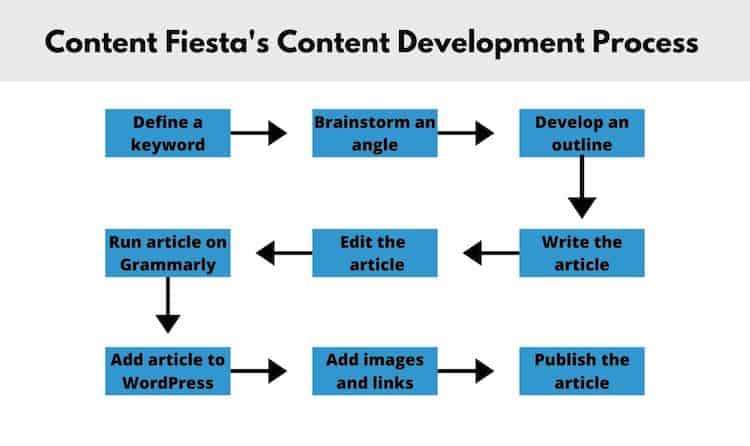Do you feel overwhelmed every time you need to publish new content?
You need a content development process that guides your entire workflow from ideation to promotion.
In this article, discover what strategic content planning entails, how it functions, and how you can create one for your company.
Let’s dive in.
What Is Content Development?
Content development is the process of creating content. It includes every step required to publish a piece of content:
- Identifying the target audience.
- Brainstorming a topic to write about.
- Prioritizing the different topics according to their relevance, impact, and needs.
- Analyzing the topic in depth to decide on an angle.
- Outlining the structure of the piece.
- Writing it.
- Editing it.
- Preparing it for publishing.
- Publishing it.
- Promoting it.
Content development is often used as a synonym for content marketing, but this is a mistake.
- A content development process is focused on the systems that make the creation and distribution of content. It organizes the different tasks required to bring a content piece to life.
- Content marketing defines the strategy and tactical execution in which content is created and distributed.
As a company starts to grow, the harder it becomes to manage its content operations. The more people involved, the harder it is to organize the work. People start missing deadlines, managers assign topics without any purpose, and the content created becomes sloppy.
A content development strategy allows for a streamlined operation, adding clarity and efficiency to its content development process.
How to Create a Content Development Strategy
Whether you are aware or not, you have a content development process in place. Your goal is to have one that serves your marketing goals. Before you can do so, you need to define a content development strategy.
A content development strategy is not the same as a content development process. While the latter represents the steps people take to create content, the former defines the organization of these steps.
Think about it this way:
- Your content development strategy defines the goals and targets.
- Your content development process represents the steps your company takes to achieve them.
If you aren’t aware of your current content development process, then you want to outline it and improve it.
If you are a team of one, then outlining your strategy will be easy to do. This doesn’t mean you shouldn’t do it; you have to.
Six months ago, I didn’t have a content development strategy in place. I just created content when I felt like it. It was a mess.
- The keywords I targeted were awful.
- My goals weren’t clear; I just created content without knowing why I was doing it.
- The entire process took me weeks, and the work was mediocre.
Then, I outlined a basic content development process. Soon after, I started publishing a 2,000+ words article a week. And I still have time for my client work, for promoting, and much more.
If your content development process involves more than one person, then have each person answer the following questions.
- What’s the ideal target audience? Can you define it in a few sentences?
- What’s your goal? Do you have a KPI?
- What makes you decide on a topic for a piece of content (i.e., article, ebook, email)? Is it a keyword? Is it customer data? Is it your inspiration?
- Do you do keyword research every time you decide on a topic? Or do you have a pre-defined set of keywords to target?
- Once you assign (or are assigned) a topic (or keyword), what research do you do?
- How long does research take you? Do you get any help from a team member?
- Do you analyze competitors’ content? If so, what do you analyze?
- Do you outline your content? If so, how long does it take you to do so?
- How long does it take you to finish a first draft? (A first draft is an early version of the content that requires editing from the writer, not the editor.)
- Do you send your content to an editor/proofreader? If so, who is that person?
- How long does it take on average to receive an edit? Do you receive many corrections?
- How long does it take you to correct the edits?
- Do you create graphics/screenshots for your content? If so, how long does it take you? If not, who’s responsible for that?
- Do you optimize your content for SEO? If so, what do you do? And how long does it take you?
- Do you write promotional content (i.e., emails, social media posts)? If so, how long does it take you? If not, who’s responsible for that?
- Do you format the content for publication? If so, how long does it take you? If not, who’s responsible for that?
- Do you promote your content? If so, what do you do? And how long does it take you? If not, who’s responsible for that?
With the answer to each question, you want to create a visual representation of the steps required, adding members responsible for each step along the way.
Here’s an example of my content development process:

As you can see, it’s a one-man show, so it’s quite simple. If I had team members involved (which I may have in the future), it would look like the one from Backlinko:

Once you have outlined the steps you currently take, you want to optimize it.
- If you see that there’s an overlap of tasks, assign tasks better.
- If you see people doing different tasks in different parts of the process, look to have one person do not more than a few tasks per step, so they don’t have to go back and forth.
- If you see people don’t do their steps on time, set the expectations properly.
It’s best to think of your content development process as a conveyor belt where each member is responsible for a few tasks in different stages. Such a division of labor made Henry Ford create one of the most influential companies in history.

Once you have outlined your content development strategy, you will see a pattern that arises from the steps involved. You can call each step as you want, but to simplify it, I have come to organize the entire content development process as a six-step workflow that involves:
- Customer analysis: You define the customer (or customers) you want to target.
- Content planning: You brainstorm a list of ideas to publish based on several factors, including customer data, keywords, and more. You prioritize each topic and assign the writer.
- Content creation: You take each idea, you outline it, write it, and edit it. If you aren’t involved in the creation itself, this is where the content writer does all the work.
- Publish: You format the content for publishing (e.g., add it on WordPress, design the ebook), and schedule it for publication.
- Promote: You promote the content through SEO, email marketing, social media, paid promotion, and more.

How to Make a Content Development Process Work for You
The critical element that makes a content development process work is that each step must be seamlessly tied to the next one; it should be clear and easy to implement.
For example, the editor should be responsible for editing a piece once the writer has finished the first draft. If the writer hasn’t completed it by the deadline, it’s best to let the writer hand it once they are ready. If the writer never delivers on time, there’s a problem with the writer or the deadlines, which you must fix from a strategic standpoint. The editor shouldn’t be involved in any task before theirs; the same applies to other people.
What’s more, your content development process must adapt to your company’s capacities and resources and the members that implement it.
Each member must be prepared to handle the tasks and educated if they aren’t. What’s more, you must provide the tools necessary to do their job efficiently—think of a content calendar app, a collaboration tool, etc. If someone has to open several tabs or apps to find something they need, something is wrong.
The entire content development process should connect with a greater content marketing strategy that defines the direction of the efforts. Remember, your content marketing strategy defines the objectives, the process organizes the steps needed to reach them.
Without further ado, let’s explain each of the five steps involved in a content development process.
Customer Analysis
The first step involves a thorough analysis of the customers you want to target with your content. It goes without saying, but your content should always aim to attract and convert an audience that leads to revenue, not just pageviews.
You should carry out this step before you can implement a successful content marketing strategy. Unlike the other steps, you don’t need to carry out customer analysis regularly. Once a quarter, semester, or year is more than enough to get you started. What’s important is that you base your content ideas from the customer analysis.
To create a customer analysis, you want to compile information on:
- Target demographics: Including age, gender, job title, etc.
- Competitors: Including those who compete in the search engine results and your industry.
- Site performance: Including the pages/posts with the most traffic, engagement, or conversions.
To find this information, you want to use tools like:
- Google Analytics: For web analytics.
- Google Search Console: For search engine analytics.
- Semrush: For SEO and competitor analysis.
- Ahrefs: For SEO and competitor analysis.
- Hotjar: For surveying your audience and analyzing their behavior on your site.
At the end of this step, you should have a list of target audiences you will write your content to. Their problems and needs will guide the next step.
Content Planning
Content planning involves a separate set of tasks that could take their own separate step. I mix them all within this step for simplicity’s sake, but you can break it down further as you see fit.
On the broadest sense, content planning involves:
- Finding a topic idea to write about.
- Prioritizing it.
- Finding an angle to the topic.
- Develop a content calendar.
- Planning the resources to each piece of content.
Find a Topic Idea
To find a topic idea, you want to:
- Brainstorm a list of topics based on the target audience’s data.
- Research keywords.
- Analyze industry competitors (those who compete for the same audience).
- Analyze search engine competitors (those who compete for the same keywords you want to target).
Prioritize Your Topics
Make a list of all your topics and prioritize them according to some of the following variables:
- Organic search traffic volume (from Ahrefs or SEMrush.)
- Keyword CPC (great for measuring intent).
- Keyword difficulty.
- Competitor’s content quality.
- Time needed to create the piece.
- Money needed to create the piece (think of an ebook design).
I usually use the first five of these variables, but I have seen content marketers use more, adding:
- The conversion potential.
- The stage of the funnel (the lower the stage, the more profitable it usually is).
- The content type (webinar, ebook, etc.).
These variables differ from each other, so you want to add a numeric value to each variable to compare apples with apples. For example:
- Keywords with more than 1,000 monthly searches use a 3, those between 100 and 999 use a 2, and those under 100 use a 1.
- Competitors whose content is detailed and useful use a 1, those whose content is long but generic or detailed but short use a 2, and those whose content is neither detailed nor useful use a 3.
- Content pieces that take a week use a 3, those that will take you between a week or two use a 2, those that take you more than two weeks use a 1.
These parameters are still entirely subjective, so there will always be room for improvement or discussion. What’s important is that you define between three to five variables, whose parameters you quantify clearly.
Once you have added numeric values to each variable and topic, summarize the column’s results and pick those topics with the highest value.
In our example, you should target the topics in descending order from those that have a nine—high-volume, low-quality competitor content, and quick to create—to those that have a one.
Find an Angle
An idea defines the overall concept of the content piece, but the angle is the exact execution that you will take to bring the content piece to life. For example:
- “Content development process” is the topic of this article, based on my keyword research.
- “How to create an efficient content development process” is the angle, which in this case, is a tutorial and focuses on efficiency.
There’s no simple way to find a content angle as it depends on the topic, the experience of the writer and/or manager, the industry, and more.
Here’s a short list of rules of thumb I use when I find the angles for my topics:
- Write about something that no one else seems to write about. For example, if everyone writes about “tips to achieve X,” you write a “how-to guide.”
- Use a different type of content. For example, if everyone writes content, you create a podcast.
- Spice your content with custom-made graphics, real-life stories, videos, photos, and so on.
- Make it shorter or longer. For example, my content is super long. If you were to compete with me, you could do so by writing zen-like short content (but please, don’t do it.)
- Become the devil’s advocate. For example, if everyone praises a subject (e.g., Elon Musk), you become a contrarian (e.g., “Why Elon Musk Isn’t Innovative.”) Make sure you have proof to back up your ideas.
Develop a Content Calendar
With the topics defined and prioritized, you want to develop a content calendar. Aim to plan an entire month at a time, at the minimum. You want to have some wiggle room between your publishing dates, so if anything goes wrong, you don’t mess the entire process. This will give time for you and your team to organize themselves properly.
I recommend setting a time, at least once a month, where you—or whoever is responsible for the content development process—define the content you will publish for the following 30 days or more. I usually have at least one month in advance of topics with defined deadlines and three months’ worth of content that can be easily assigned once I see I haven’t missed a single deadline.
Make sure that everyone who is involved in this process is notified and aware of their deadlines. Let them ask questions or share doubts, so everyone is on the same page.
Plan the Resources
The last part is where you plan the resources needed to do their best job without any interference.
- Does a team member need access to a specific document? Give them access to it.
- Do they need access to a specific piece of software (like Grammarly)? Give them access to it.
- Do they need to plan a promotional campaign? Discuss a budget and approve it.
What’s more, discuss the tasks with everyone involved in the content development process and make sure you understand what they are doing. Everyone should be able to collaborate with everyone else without interfering with their work.
Keep It Simple, Silly You!
Ideally, this entire step should be relatively straightforward. The first time you implement it may look complicated, but as you work on it, it will get progressively easier to understand and act on.
Content Creation
Everything done so far leads us to this step. This is the one everyone obsesses about, but without a clear foundation, it will lead nowhere.
This step can be split into two sub-steps:
- Content creation: This is where the writer(s) create the content. It includes their research, interviewing, pre-production (if it involves developing a video), and more.
- Content editing: This is where an editor checks for grammar, spelling and punctuation mistakes, clarity, and tone issues.
Content Creation
If you implement your content creation, then you want to start working by the time your task is due. If you want to learn more about writing great content, please check out the following posts:
- How to Become a Better Writer (Complete Guide)
- 10 Persuasive Writing Techniques to 10X Your Marketing Copy
- 10 Proven Writing Techniques that Work Great
- Blog Writing Tips: Here’s How to Write Better Content This Year
If you aren’t responsible for creating your brand’s content, you will have to hire people to do it for you. To do so, you have several options available:
- Hire full-time writers: Ideal for those who want to publish more than long-form content several times per week and who also need different types of content created (e.g., ebooks, social media, articles, etc.). Full-time writers are often more expensive than freelance writers (see next) but represent a brand better. They can also own the entire process, saving you time.
- Hire freelance writers: Ideal for those who want a more flexible, remote workforce. They can be cheaper—up to an extent—and easier to hire and fire, but they can also come with risks; namely, they can use the wrong voice, style, and tone. If handled properly, freelance writers can be an excellent option for brands starting with their content marketing efforts.
- Work with subject-matter experts (SME): Ideal for those who want to create authoritative content regularly that hasn’t been covered before. This is the best type of content, one that’s increasingly needed due to the high volume of generic, low-quality content. These SMEs can include internal experts (e.g., an executive) or external ones (e.g., experts that contribute free content for exposure and recognition).
Content Editing
One issue I’ve experienced many times is that two or more people become involved here. A manager checks for… who knows what. Then, an editor checks for the issues I mentioned before.
There’s an overlap of tasks that dilutes the effectiveness of the editor work. Managers and executives can look at the content produced, but it shouldn’t be their job to edit it.
Anyone who’s not professionally trained as an editor should never edit content, except for meaning. That is, they should check whether a piece of content meets its goal; if it speaks to the audience and showcases subject-matter expertise. If it doesn’t, then:
- There was a problem with the topic/angle assignment—wrong person, wrong topic, bad writer, bad documentation of target audience and content strategy goal.
- A “non-editor” can make changes, but only with the help of the writer.
Otherwise, it’s the editor’s job to edit. This involves:
- Improving clarity and comprehension.
- Fixing grammar mistakes.
- Making the content relevant for the target audience.
- Tighten the voice, tone, and style to adapt it to the style guide.
- Optimize it for SEO (although not always the case).
Publishing
The fact a piece of content is ready to publish doesn’t mean it can be published. In this step, you add the content to your CMS—most likely, WordPress—and format the content appropriately.
If your content is an article, this work includes:
- Formatting the headings, bolding, and italics.
- Adding images and links.
- Optimizing for SEO (i.e., title tags, meta descriptions).
If your content is an ebook, this work will include:
- Working with a designer to design the ebook.
- Add the ebook to your email marketing service.
- Creating a landing page (if needed).
There’s more to this step than it meets the eye, so make sure to assign it enough time so every content piece goes out the door as it should be.
Promotion
The last step is the part where many content marketers forget. Content without marketing is journalism. You need to plan and execute a content promotion campaign.
This step requires its own strategy, which I won’t explain in this article. On a broad sense, a basic content promotion strategy involves:
- Defining the tactics you will regularly implement for each piece you promote.
- Running an email outreach campaign for link building or press mentions.
- Creating a Facebook ads campaign.
- Publishing it in online communities and your social media accounts.
- Sending an email marketing campaign to your audience.
Most likely, marketers will be involved in this step. That is:
- Growth hackers.
- Facebook ad specialists.
- SEO specialists.
- Email marketers.
- Community managers.
Don’t let their silos abstain them from participating in your content development process. They should have a saying in it as the promotion is as important as the creation.
What’s more, your content creators should also be involved in its promotion, even if that means sharing it on social media.
Promoting content is a never-ending process you need to always work on. The more content you create, the more you should promote both your new and old material.
Create Your Content Development Strategy
If you never seem to know what’s happening in your content marketing team, or if you can’t develop a consistent publishing schedule, you need to create a content development strategy.
Use the structure I recommend here, but feel free to adapt it to your own needs. As I said, you can break down each step in many different pieces. Start with the simplest, most basic strategy process—the one laid out here—and increase its complexity as you see you progress.
The better your content development process, the more efficient your content marketing strategy will become. Give it a try; it will change your business.

